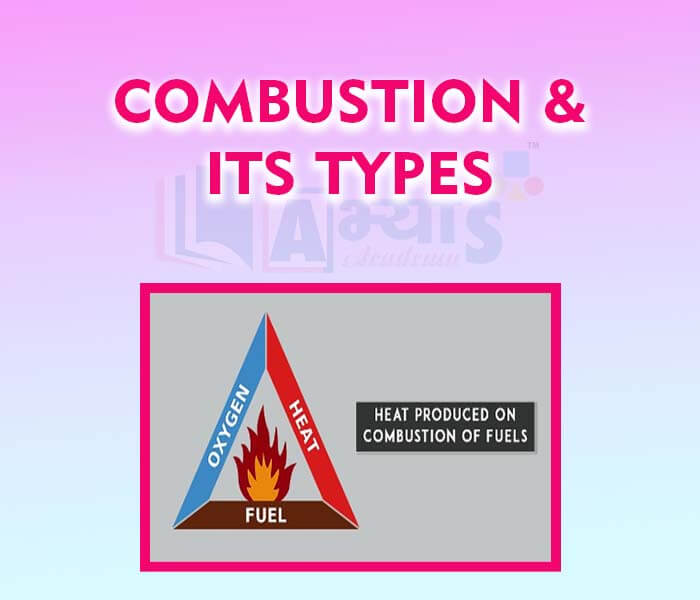Combustion and its Types


Combustion and its Types
Combustion
The chemical process of burning of a substance in the presence of air or oxygen with the liberation of heat and light is called combustion. Substances can be classified as:
Types of combustion:
1. Rapid combustion: larger amount of heat and light are released in a very short span of time. E.g. combustion of LPG, which produces heat light intently. They also require external heat. Cooking gas (in our homes), spirit, petrol and camphor go to flames even with a spark from gas lighter. These materials are highly inflammable. You might have observed "Highly Inflammable " written on petrol tankers. This is a warning to keep a flame away from these tankers.
2. Explosion: Characterized by sudden release of heat, light and sound e.g.: bursting of firecrackers.When a cracker is ignited it explodes with a big -bang producing heat and light (sparkles.) Same is the true with the firing of gun. Big sound is produced along with combustion. Fire wood burns with a crackling sound.
3. Spontaneous combustion: Substances catch fire on their own, without the application of external heat e.g. white phosphorous.In this type of combustion a material suddenly bursts into flames without the application of any apparent cause for e.g. spontaneous forest fires are sometimes due to the heat of the sun or lighting strike.
Combustion of hydrocarbons can be divided in to two types :-
1. Complete combustion: Combustion takes place in adequate amount of air or oxygen. It results in the formation of carbon dioxide, water, heat and light.
2. Incomplete combustion: Combustion take place in inadequate amount of air or oxygen .It result in the formation of carbon monoxide, soot, water, heat and light.
Soot : Black powdered substance produced on incomplete combustion.
Condition necessary of combustion:
1. Presence of combustion substances: Combustion is only possible in the presence of combustion substance i.e. called fuel. e.g. wood, charcoal, petrol etc.
2. Presence of a supporter of combustion: Adequate amount of supporter of combustion e.g.: oxygen.
3. Attainment of ignition temperature: A substance start to burn after attainment of certain minimum temperature. The temperature at which a particular substances burn in the presence of air is called ignition temperature. A substance cannot catch fire below its ignition temperature.
Note: A substance will not burn without one or more of these conditions.
Inflammable substances: Substances like petrol, LPG, alcohol catch fire easily because they have low ignition temperature and are inflammable substances.
Combustion is a chemical process in which a substance (fuel) burns in the presence of air (oxygen) with the release of heat and light. On combustion the burning fuels gets combines with oxygen to form new substance. Sometimes, combustion is accompanied with the production of sound as well.The sound produced may be a hissing sound, crackling sound or an explosion.
`
When compounds undergo combustion, two or more combustion products are formed. When carbon - hydrogen compounds undergo combustion is an excess of oxygen, the combustion products are carbon dioxide and water.
The metabolism of glucose , blood sugar that occurs in our bodies the energy to sustain our life is also a combustion reaction that occurs at a steady rate
| |||||||||||||
| Right Option : C | |||||||||||||
| View Explanation | |||||||||||||
What kind of combustion is undergone by ignition of a cracker? | |||
| Right Option : A | |||
| View Explanation | |||
Burning of charcoal in a closed room will produce a. Carbon dioxide b. Nitrogen dioxide c. Carbon monoxide d. All of these | |||
| Right Option : C | |||
| View Explanation | |||
Students / Parents Reviews [10]
About Abhyas metholodology the teachers are very nice and hardworking toward students.The Centre Head Mrs Anu Sethi is also a brilliant teacher.Abhyas has taught me how to overcome problems and has always taken my doubts and suppoeted me.

Shreya Shrivastava
8thMy experience with Abhyas academy is very good. I did not think that my every subject coming here will be so strong. The main thing is that the online tests had made me learn here more things.

Hiya Gupta
8thAbhyas is a complete education Institute. Here extreme care is taken by teacher with the help of regular exam. Extra classes also conducted by the institute, if the student is weak.

Om Umang
10thMy experience with Abhyas is very good. I have learnt many things here like vedic maths and reasoning also. Teachers here first take our doubts and then there are assignments to verify our weak points.

Shivam Rana
7thAbhyas Methodology is very good. It is based on according to student and each child manages accordingly to its properly. Methodology has improved the abilities of students to shine them in future.

Manish Kumar
10thMy experience was very good with Abhyas academy. I am studying here from 6th class and I am satisfied by its results in my life. I improved a lot here ahead of school syllabus.

Ayan Ghosh
8thOne of the best institutes to develope a child interest in studies.Provides SST and English knowledge also unlike other institutes. Teachers are co operative and friendly online tests andPPT develope practical knowledge also.

Aman Kumar Shrivastava
10thIt has a great methodology. Students here can get analysis to their test quickly.We can learn easily through PPTs and the testing methods are good. We know that where we have to practice

Barkha Arora
10thBeing a parent, I saw my daughter improvement in her studies by seeing a good result in all day to day compititive exam TMO, NSO, IEO etc and as well as studies. I have got a fruitful result from my daughter.

Prisha Gupta
8thIt was a good experience with Abhyas Academy. I even faced problems in starting but slowly and steadily overcomed. Especially reasoning classes helped me a lot.
